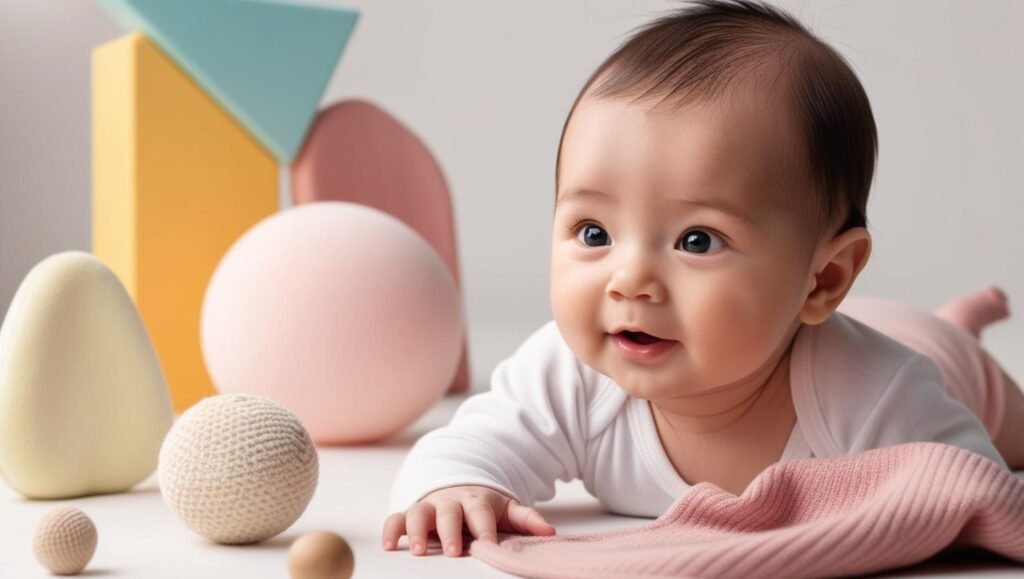Discover how your baby observes and understands the world—from recognizing your smile to learning empathy. Learn how to nurture their emotional and cognitive growth in the critical first year.
The First Glimpse of Connection
When Riya first held her newborn son, she marveled at his wide-eyed curiosity. What does he see? she wondered. Days later, she noticed something magical: when she smiled, he almost smiled back. And when tears streamed down her face one exhausting night, her baby cried too, as if mirroring her pain.
This wasn’t a coincidence. Babies are born observers, absorbing every sight, sound, and emotion long before they can speak. Let’s explore how your baby’s early observations shape their emotional, social, and cognitive future—and how you can support them.
1. “What Can My Baby Actually See?” – The First Month
Newborns see the world in blurry shades of gray, but they’re drawn to faces—especially yours. By one month, they:
- Recognize your voice (they’ve known it since the womb!).
- Focus on your eyes and mouth, studying your expressions.
- Sense your emotions: If you’re stressed, their tiny heart rate may spike.
Real-life example: When Riya cried, her son cried too. This “emotional sync” is thanks to mirror neurons—brain cells that help babies mimic feelings, laying the groundwork for empathy.
2. Emotional Milestones: From Smiles to Empathy
0–6 Months: Mirroring Emotions
- Babies start copying smiles by 2 months.
- They cry when you’re upset, not just from hunger or fatigue.
6–12 Months: Reading Faces
- They distinguish joy, anger, and sadness in your expressions.
- A worried frown might make them freeze, while a grin triggers giggles.
After 1 Year: Early Empathy
- Toddlers may pat your cheek if you’re sad or share a toy to cheer you up.
Why it matters: Consistent emotional responses teach babies trust. (“When I cry, Mom comforts me.”) This shapes their ability to form healthy relationships later.
3. “Where Did It Go?” – How Babies Learn About the World
Ever play peek-aoo? Around 6–8 months, babies develop object permanence—the understanding that things exist even when hidden. Before this:
- A hidden toy = “Gone forever!”
- After this milestone: They’ll search for it, delighting in the “reveal.”
Cognitive leap: This skill is the foundation for memory, problem-solving, and even separation anxiety (they now miss you when you’re out of sight).
4. The Science of Baby Brain Development
Mirror Neurons: The “Copycat” Cells
- These neurons fire when your baby watches you smile, cry, or wave.
- They’re why your baby sticks out their tongue when you do—and later, shares toys.
Attachment Theory (Bowlby):
- Secure attachment: Formed when you respond warmly to cries and cues. These babies grow into resilient, confident kids.
- Insecure attachment: Results from inconsistent care, linked to anxiety or behavior issues.
Piaget’s Sensorimotor Stage:
- Babies learn through senses and movement (touching, tasting, dropping spoons!).
- Every “experiment” (like shaking a rattle) builds neural pathways.
5. Building a Nurturing Environment: 4 Simple Tips
- Talk and Sing: Narrate your day. Even silly songs boost language skills.
- Respond to Cries: Comforting your baby teaches them the world is safe.
- Play Peek-a-Boo: Reinforces object permanence and delights them.
- Limit Stress: Babies sense tension. Prioritize calm moments—even 10 minutes of cuddling lowers cortisol (stress hormone).
You Are Their First Teacher
Your baby’s brain is a sponge, absorbing every interaction. Those early smiles, games, and soothing words aren’t just bonding—they’re building the architecture of their mind. By being present and responsive, you’re giving them tools to navigate emotions, solve problems, and connect deeply with others.
Remember: You don’t need to be perfect. Just being there—soothing, smiling, and exploring together—is enough to nurture a thriving, curious little human.
